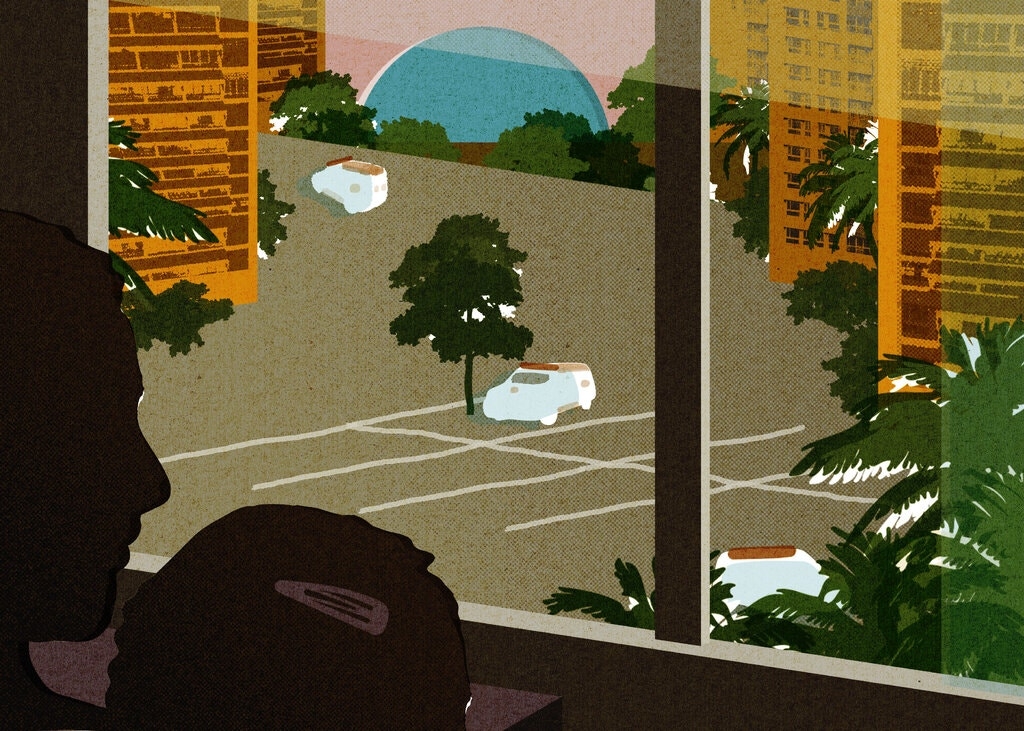We spend our days watching ambulances, as Covid-19 rips through the country.
Ler em português | Read in English
The New York Times
19 de abril de 2021
by Vanessa Barbara
Contributing Opinion Op-ed Writer
SÃO PAULO, Brazil — From the balcony of my apartment, I can see an ambulance parking lot. For over a year now, my 2½-year-old daughter and I have been monitoring — avidly, anxiously — the movements of the 10 ambulances parked there. That’s the sort of entertainment we have now.
“Look, another one is getting back!” she says, pointing at an ambulance as it stops and turns off its red-and-white lights. It’s not exactly rigorous analysis, I know, but I judge the severity of the pandemic by looking at this parking lot. Since the beginning of the year, fewer and fewer ambulances stay put. Now, during the day, it’s common to see only one or two vehicles at the lot — and never for long. Just wait awhile and away they go, sirens blaring, to answer someone’s call.
Official statistics confirm our observations. In the state of São Paulo, where I live along with 46 million others, the rate of Covid-19 hospitalizations more than doubled in the four weeks from Feb. 21 to March 21. At the beginning of April, an average of 3,025 people were being admitted daily to a hospital — a rise of 58 percent from the start of the previous month. I try to explain to my daughter, in a lighthearted way, that these ambulances are transporting sick people to the hospital, where they are going to take some fruit-flavored medicine and get better very quickly.
Looking at that incessant parade of ambulances, I try not to sound desperate. I try to keep from my voice the knowledge that 543 people have died waiting for a hospital bed since the end of February in São Paulo alone, that across the country over 370,000 people have lost their lives — and that the worst may be yet to come. (After all, in the Southern Hemisphere, winter is just around the corner.) But I can’t hide the impotence and anger I feel, trapped in a small apartment for who knows how much longer, watching the tragedy unfold.
There was one glorious intermission, though. In early February, my husband and I enrolled our daughter in a private school with plenty of trees and fresh air. The classrooms are spacious and airy, and many lessons are held outdoors. I’ve never seen her so happy. Her social and emotional development soared. She sang randomly and chatted about her new friends.
But in early March, she tested positive for the coronavirus. She had mild symptoms: low fever, a runny nose, a cough. We gave her 14 drops of acetaminophen, which she doesn’t love, once every six hours, for three days. She dutifully complied. Her classmates and teachers also entered a 14-day isolation, although nobody else tested positive. She quickly recovered; my husband and I tested negative. We couldn’t trace the source of her illness, though we assume it must have been someone at the school. “An immaculate infection!” my husband joked.
By the time our quarantine ended, in mid-March, São Paulo’s governor had declared a state of emergency, closing all schools. The virus was ripping through the country, claiming a record number of lives. A friend of mine who works as a nurse said that it was now common to see a traffic jam of ambulances in front of hospitals. Outside our apartment, the parking lot was bustling.
It was an entirely foreseeable escalation. Since the virus reached Brazil in March last year, we’ve never really had a proper lockdown, regionally or nationally. While state governors and city mayors have tried to institute some restrictions, President Jair Bolsonaro has consistently advocated the free circulation of people — and, consequently, the virus.
The results could not be starker: There are on average around 3,000 deaths per day, a staggering number spurred by a new, more contagious variant of the coronavirus. Of daily Covid-19 deaths worldwide, Brazil currently accounts for almost a third. In dozens of states, I.C.U.s are 90 percent or more full. Calamity doesn’t begin to cover it.
The vaccination rollout, chaotic at first, is still slow. My 72-year-old father finally received his second dose 10 days ago; my 67-year-old mother just got her first shot last week. Only 4.5 percent of the population is fully immunized, compared with 25 percent in the United States. Our public health system is capable of doing much more, but we simply don’t have enough vaccines. We shall never forget that last year Mr. Bolsonaro’s government turned down an offer of 70 million vaccine doses from Pfizer.
Many other countries are beginning to emerge from the crisis, while ours plunges ever deeper into catastrophe. But Mr. Bolsonaro — who has actively discouraged social distancing, tests and vaccines — couldn’t care less. “Enough fussing and whining,” he said in March. “How much longer will the crying go on?”
Without the vaccines or political will to curb the virus, we don’t have many options left. We can’t take to the streets to protest — at least not without a high risk of infection — and the next election is a year and a half away. More than 370,000 Brazilians are gone forever. As for the rest of us, we continue to live as prisoners in our own homes, watching the ambulances go by.
A version of this article appears in print on April 20, 2021, Section A, Page 25 of the New York edition with the headline: “Trapped in Brazil’s Covid Tragedy”.


